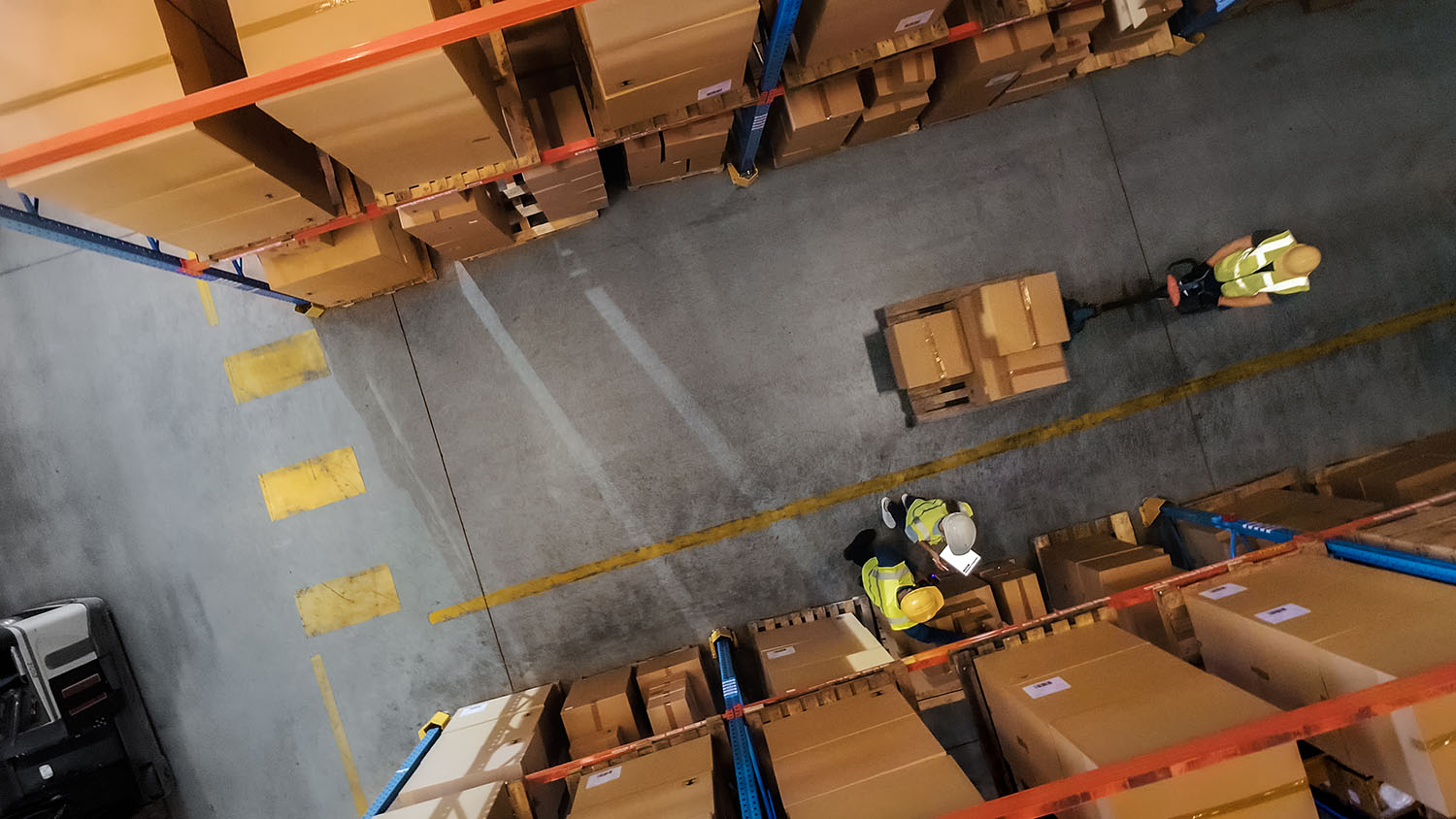When products sit too long in a warehouse, they take up space, require extra handling, and increase the risk of fulfillment errors. 3PLs must constantly track and manage inventory flow to prevent revenue loss, warehouse overcapacity, and operational delays.
Inventory carrying costs help you measure how much it costs to hold inventory, and use that data to make smarter storage, billing, and fulfillment decisions.
Studies show manual warehouse operations can spend 22–33% of inventory value each year just holding stock. A warehouse management system (WMS) allows you to track your inventory flow and clear out or prevent deadstock sustainably through real-time visibility.
In this article, we’ll discuss what inventory carrying costs are, how to calculate them, and best practices 3PLs can use to manage them.
What Are Inventory Carrying Costs for 3PLs?
Inventory carrying cost (ICC) is the total cost of storing products in your warehouse, starting from the day they arrive until they’re shipped.
When items sit on shelves, a 3PL needs to consider the cost of storage space, the staff to manage them, the systems to track them, and the risk of being damaged, stolen, or expired.
Over time, these costs affect 3PL profit margins, especially if you’re not billing clients properly or rotating stock fast enough.
There are four main components of inventory carrying costs for 3PLs:
- Capital Costs: While 3PLs don’t own their clients’ inventory and don’t have capital tied up in unsold stock, they do face opportunity costs. Warehouses have finite storage capacity, and space occupied by slow-moving client inventory could otherwise be rented to more active accounts. A 2,000-square-foot area holding $200K worth of a client’s unsold stock might generate higher monthly revenue if allocated to a faster-turnover client.
- Storage Costs: Storage costs include the infrastructure of warehouse rent, utilities, racking systems, and equipment. According to industry studies, floor space and equipment costs alone 20–40% of carrying costs in manual warehouses. For 3PLs, these costs are typically passed to clients through storage fees based on square footage or pallet positions used.
- Service Costs: Service costs encompass the labor and resources required for receiving, putaway, inventory counts, order picking, and system updates. 3PLs must invest in staff, warehouse management systems, and equipment to track and handle client inventory efficiently.
- Risk Costs: Risk costs account for potential losses from spoilage, theft, damage, or obsolescence that may impact the client’s inventory while under the 3PL’s care. For example, storing temperature-sensitive goods requires special equipment and handling to prevent spoilage. While the client bears the financial loss if items become unsellable, the 3PL may face contractual obligations or damage to their reputation, making management of risk costs crucial.
How to Calculate Inventory Carrying Costs?
Inventory carrying cost is usually measured as a percentage of the average inventory value. This percentage tells you how much it costs to hold unsold goods over time based on factors like storage, labor, capital, and risk.
Here’s the inventory carrying cost formula:
Inventory Carrying Cost (%) = (Total Annual Carrying Costs ÷ Average Inventory Value) × 100
- To calculate average inventory value, you take the value of inventory at the beginning and end of a period, then divide by two.
- The annual carrying costs include all aspects of storage, labor, capital, and risk costs as mentioned above.
Challenges 3PLs Face in Managing Inventory Carrying Costs
For businesses, inventory is often their single largest asset, and staying on top of measuring it gives them an advantage over less metrics-oriented competitors. “The Japanese considered inventory as ‘evil,’ says Blair Williams, a supply chain master instructor long associated with the Association for Supply Chain Management (ASCM). “We in the USA do not really have Inventory Control as a priority.”
Even though 3PLs don’t own their inventory, they also gain from staying on top of inventory carrying costs. Here are some challenges 3PLs face in doing that:
Unpredictable Demand
E-commerce brands often send excess inventory after a viral moment, like a Shark Tank appearance, influencer endorsement, or peak holiday season. They overestimate sell-through and ship large volumes to warehouses to avoid stockouts, but when demand slows, the inventory lingers.
3PLs end up dealing with extra stock, running out of space, and spending more time and money on inventory that just sits there.
Hidden Costs Are Often Overlooked
3PLs often don’t consider the hidden costs like obsolescence, repackaging, product damage, and lost sales. These hidden costs are sometimes equal to or even higher than the evident ones, like warehouse rent or labor.
Many 3PLs either rely on manual spreadsheets or have outdated systems that only measure obvious costs like labour or equipment use.
Lack of Standard Cost Percentages
There’s no standard percentage benchmark when measuring inventory carrying costs across industries. Each warehouse must calculate costs based on its unique systems and product types.
Missed Billing Opportunities
3PLs that do manual billing often miss charges for extended storage, pallet changes, or special services like temperature control. Over time, that means lost revenue and tighter margins, especially when handling multiple clients with different needs.
Lack of Client Cost Awareness
When brands don’t understand what it costs to store their products over time, they don’t prioritize inventory turnover or cleanup. They may leave unsellable or excess stock in your warehouse without urgency, assuming space is always available.
3PLs are stuck holding that inventory longer, which increases operational workload without increasing revenue. This complicates controlling carrying costs or freeing up capacity for more profitable accounts.
Manual Warehousing Systems Are Prone to Inaccuracy
Manual warehouses often rely on spreadsheets or paper-based logs to track inventory activity. It’s difficult to capture accurate costs, especially for issues like product damage, shrinkage, or misplaced items that require constant manual inspection and follow-up.
Benefits of Measuring Inventory Carrying Costs
Here are the benefits of calculating inventory carrying costs for 3PLs:
Increase Warehouse Throughput
Warehouse throughput refers to the rate at which goods move through your facility, from receiving to shipping. By calculating inventory carrying costs, you can identify slow-moving or aging stock early. This gives you enough time to clear space and make room for higher-demand inventory, keeping operations moving smoothly.
Enable Accurate Pricing and Billing Models
When you understand the true cost of holding inventory, including rent, insurance, labor, and utilities, you can design smarter pricing structures and billing models. Whether it’s charging for extended storage, temperature-controlled zones, or high-turnover items, these insights help you recover costs, protect margins, and maintain transparency with clients.
Long-Term ROI (Return on Investment)
With better visibility into inventory behavior, you can achieve long-term profitability. It also helps you improve slotting by placing high-demand items closer and low-demand items farther from the packing zone.
You can also improve your space usage and make smarter layout decisions that promise returns over time.
Lower Energy Use and Reduce Waste
When you measure carrying costs, you can clear out deadstock faster. This helps reduce lighting, HVAC, and equipment usage, reducing energy waste across underutilized warehouse zones.
It also helps you and your clients reduce excessive item production or pre-plan how to dispose of or recycle expired, damaged, or obsolete items.
Supports Investment Planning
Knowing how much it costs to store inventory helps you make smarter use of warehouse space and equipment.
For example, if most of your storage costs come from fixed things like rent, equipment, and shelving, the best way to improve ROI is to make sure that space is always used.
5 Best Practices to Reduce Inventory Carrying Costs
Here’s how you can reduce inventory carrying costs:
1. Segment your SKUs
Separate your SKUs (stock-keeping units) into categories. Fast-moving SKUs should be stored in high-access areas to reduce pick time. Seasonal items may need short-term priority space, then be moved or cleared post-season.
Deadstock should be isolated and flagged for client review or removal. Treating each type differently helps you free up space and focus labor on SKUs that generate revenue.
This warehouse putaway process improves slotting decisions and prevents valuable warehouse space from being locked up by deadstock.
Da Vinci’s advanced WMS features help you identify your high-demand and low-demand SKUs using order history. The software uses advanced algorithms to assign each SKU to storage locations based on size, frequency, and space availability in real-time.
2. Run Inventory Aging Reports
Regularly review your inventory aging reports. This helps you spot SKUs that have been sitting too long. Items stored beyond 30, 60, or 90 days without movement tie up space, increase handling costs, and limit your ability to take on higher-turnover goods.
These reports are important for initiating client conversations, applying long-term storage fees, or clearing space for more profitable inventory. It’s one of the simplest ways to reduce carrying costs and improve warehouse performance over time.
3. Forecast Collaboratively
Work closely with your clients to predict how much inventory they’ll send, how often, and when peak demand might hit. This helps you allocate space, distribute labor tasks, and avoid costly delays.
But doing this manually often leads to inaccuracies. You need a WMS to collect, track, and analyze your existing fulfillment data to predict demand patterns and plan accordingly.
Da Vinci’s cloud-based WMS uses demand forecasting to help you predict inventory needs and avoid overstocking or stockouts. The software allows real-time tracking to monitor stock levels and support faster storage decisions.
4. Measure Cost per Outbound Order
Track your cost per outbound order to measure how much it costs to fulfill each shipment, from receiving to shipping.
Here’s the formula:
Cost per Outbound Order = Total Outbound Operational Costs ÷ Number of Outbound Orders
For example, if it takes $7 in labor and materials to pack and ship an order, but your billing model only charges $5, you’re losing $2 per order. When done massively, this can affect your revenue.
You can also measure other inventory management KPIs to protect your margin, especially when order volumes fluctuate.
5. Use WMS for Warehouse Visibility
According to NTT Data, 68% of shippers rank real-time visibility tools as their top must-have feature when choosing a 3PL partner. Integrating an automated system like Da Vinci WMS gives you real-time visibility across receiving, putaway, picking, packing, and shipping.
With Da Vinci, you can easily identify stock driving up carrying costs, so you can re-slot slow movers, apply billing rules, or clear space faster.
Da Vinci’s WMS also includes a Customer Portal with permission-based profiles. Your clients can log in, track inventory levels, and identify high-demand SKUs to avoid overstocking or understocking.
Final Thoughts: Turn Inventory into a Revenue Opportunity
Balancing dozens of clients and thousands of SKUs can increase your inventory carrying cost. You need to take a proactive approach to reduce these costs before they cause a financial loss.
With 87% of shippers increasing their use of outsourced logistics, 3PLs face more competition and higher client expectations than ever. You need real-time cost tracking, visibility into aging stock, and smarter slotting decisions to meet client demands.
Da Vinci’s WMS simplifies your storage utilization, stocking inventory, and real-time tracking with smart algorithms and automation capabilities. Our software integrates with your existing systems, providing complete visibility into your inventory carrying costs and order fulfillment process.
Book a demo to learn more about Da Vinci’s advanced WMS features.
FAQs
What is the formula for inventory cost?
Here’s the inventory cost formula for 3PLs: Inventory cost = ordering cost + holding cost + shortage cost + purchase cost. This formula helps you measure the total cost of acquiring, storing, and managing inventory.
What is EOQ and holding costs?
EOQ (economic order quantity) is the ideal number of units to order that reduces total inventory costs, including ordering and holding costs. Holding costs are the costs of storing unsold goods, like storage space, labor, insurance, and product loss.
What are the five inventory holding costs?
Inventory holding costs include capital, storage, service, risk, and labor costs.



